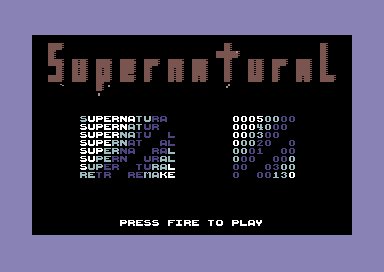And yet another cosmetic step. The highscores receive a nice color warp. Pretty easy to implement, on every frame simply exchange the color bits where the score is displayed, and voila!
First setup up the fade counter in front of the TitleLoop:
;init color fade counter
lda #0
sta COLOR_FADE_POS
And the quite simple effect. First increase the counter (and check for overflow via AND). To get the proper offsets in the color RAM we reuse the screen line offset table (the lo byte is the same) and add on the differece in the hi byte.
For every line the fade pos is offset by one so the effect is applied diagonally. Read the color value from the table, write to color RAM, repeat for all lines, done.
;apply color fadeinc COLOR_FADE_POS
lda COLOR_FADE_POS
and #( COLOR_FADE_LENGTH - 1 )
sta COLOR_FADE_POS
lda #0
sta PARAM1
.FadeLine
lda PARAM1
clcadc #10
tay
lda SCREEN_LINE_OFFSET_TABLE_LO,y
sta ZEROPAGE_POINTER_1
lda SCREEN_LINE_OFFSET_TABLE_HI,y
clcadc #( ( ( SCREEN_COLOR - SCREEN_CHAR ) & $ff00 ) >> 8 )
sta ZEROPAGE_POINTER_1 + 1
ldy #6
lda COLOR_FADE_POS
clcadc PARAM1
and #( COLOR_FADE_LENGTH - 1 )
tax
.FadeColorNextChar
lda COLOR_FADE_1,x
sta (ZEROPAGE_POINTER_1),y
iny
cpy #35
beq .FadeColorLineDone
inx
cpx #COLOR_FADE_LENGTH
bne .FadeColorNextChar
ldx #0jmp .FadeColorNextChar
.FadeColorLineDoneinc PARAM1
lda PARAM1
cmp #8
bne .FadeLine
.. common TitleLoop code
And here's the used constants. You can play around with these, but keep in mind, COLOR_FADE_LENGTH needs to be a power of 2. Also, since the charset mode is set to multi color you can only safely use color indices below 8.
COLOR_FADE_LENGTH = 16
COLOR_FADE_1
!byte 0,0,6,6,3,3,1,1,1,1,1,1,3,3,6,6

